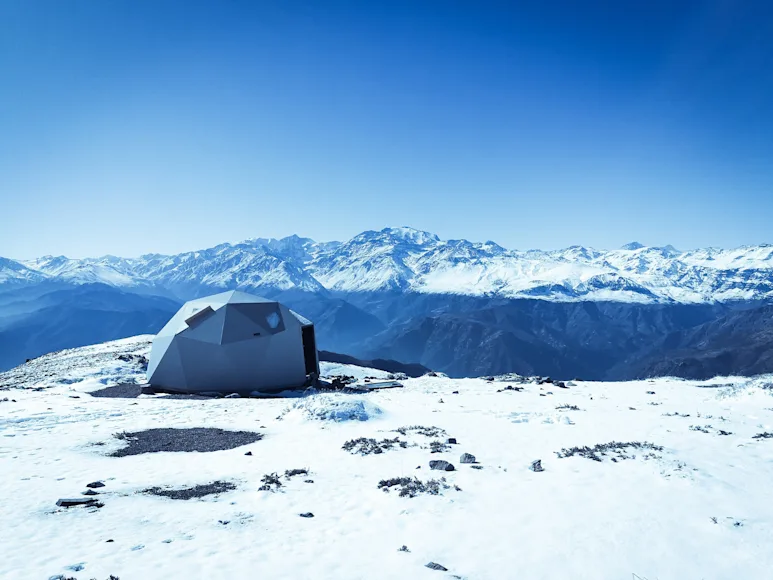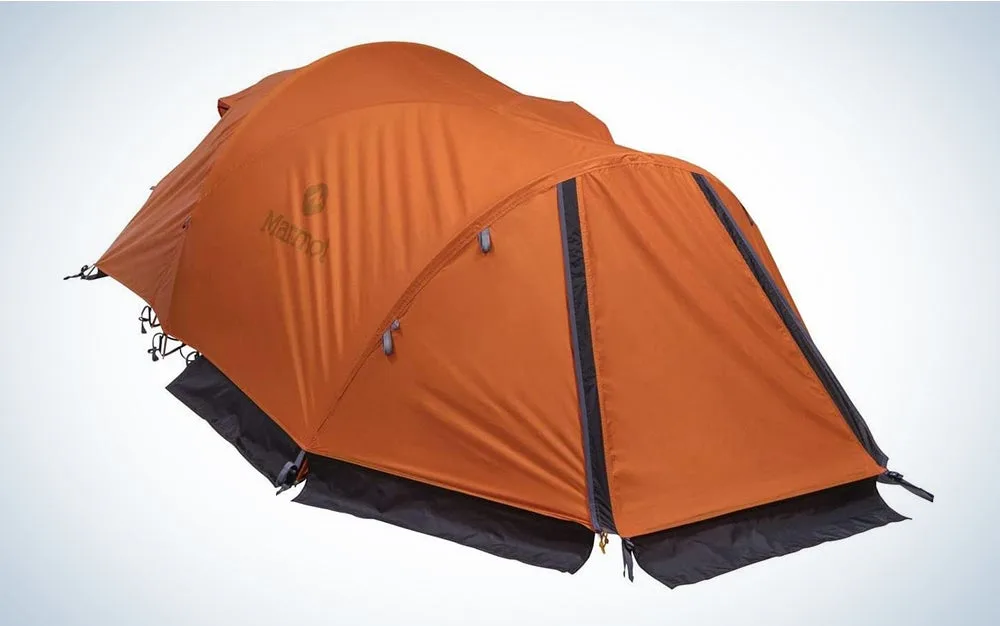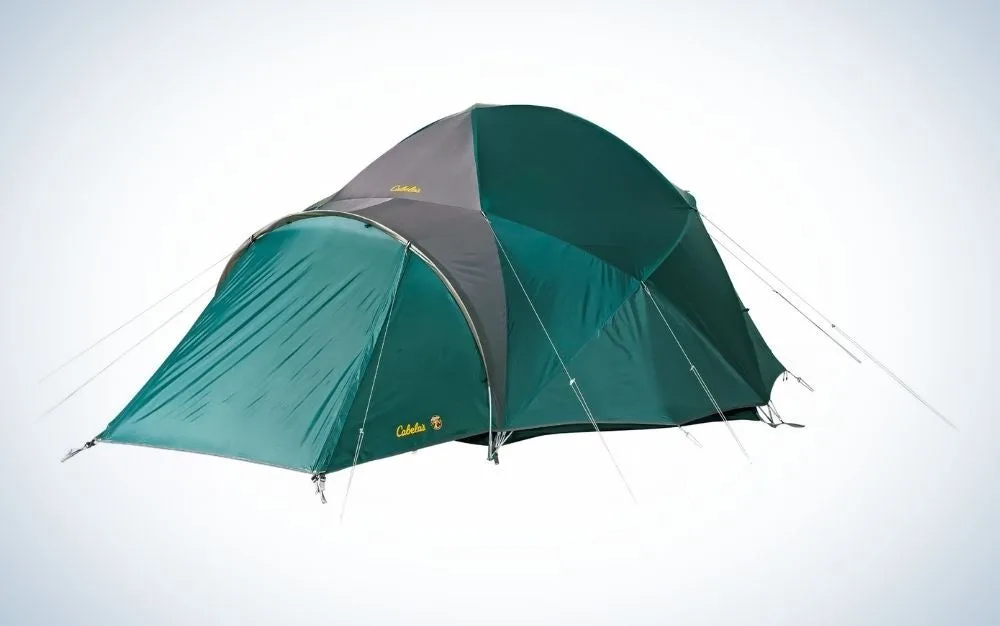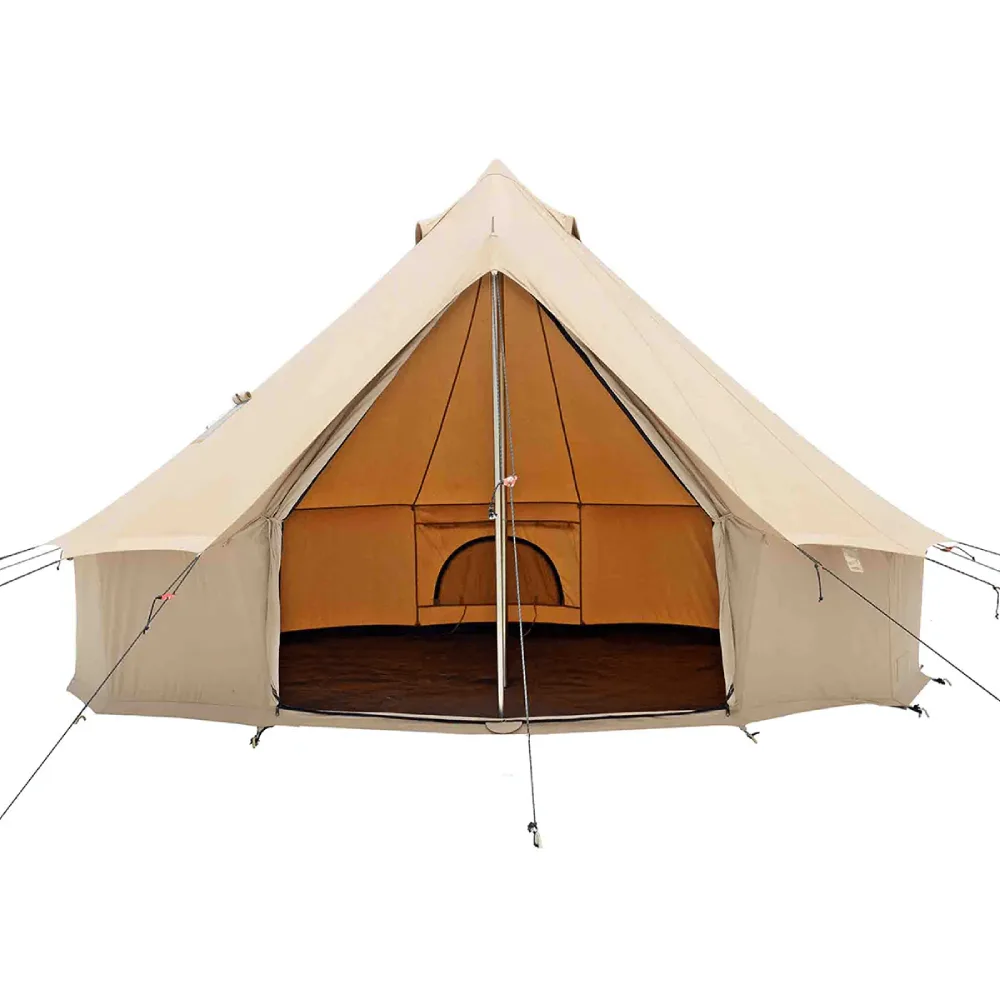We may earn revenue from the products available on this page and participate in affiliate programs. Learn more
Serious outdoorsmen and women know that camping isn’t just a warm-weather activity—but camping in cold weather requires a good winter tent. Whether you’re at hunting camp in late November or planning a camping trip in blustery January, you must come prepared to spend a night in freezing temperatures in the backcountry. The average camping tent won’t keep you warm or dry during a blizzard—you need shelter built for the snow and cold.
Winter tents are markedly different from regular tents. They’re often built with different materials, less ventilation, and more insulation than the tent you’d use in the summer. Some even boast built-in stoves or stove ports, letting you keep a fire inside to keep the cold away during even the most frigid winter nights. We’ve reviewed and ranked the best winter tents from top tent brands like Marmot and White Duck for your next colder weather expedition.
Best 4-Season: Marmot Thor
Best Canvas: White Duck Regatta Canvas Bell Tent
Best Insulated: Cabela’s Alaskan Guide Model Geodesic Tent
Best for Ice Fishing: Frabill Pro Series Ice Hub Shelter
Best Budget: FireHiking Camping Hot Tent
How We Tested Winter Tents
Choosing the best winter tent is a personal decision that also needs to revolve around safety and protection during harsh winter weather.
Considerations that influenced tents chosen for the best winter tent:
Functionality: How well does it hold up in winter weather conditions such as high winds, snow, freezing rain, and cold temperatures? What is the intended purpose (i.e., backpacking, expeditions, spike camp)?
Longevity: What is the expected lifespan of the tent? Is there a company repair policy or lifetime warranty? Are the materials designed for use in winter?
Maintenance: How often does the tent need a waterproof coating applied? Are the seams sealed, or will that need to be done? What other standard maintenance is necessary for the ideal longevity of the tent?
We rely primarily on outdoor experience and product testing to guide our gear picks. Where we need to, we fill the gaps with company-specific research, recommendations from others, verified customer reviews, and general industry or product knowledge. Roundups are updated periodically to reflect new product updates, new picks, and updated reviews from testing.
Best 4-Season: Marmot Thor

Specs
Materials: 100% polyamide (base), 100% polyester (outer tent)
Floor Area: 36.6 Square Feet
Best Uses: Expedition, climbing, winter camping
Pros
Easy setup
Relatively portable for the size
Waterproof
Lifetime warranty
Cons
Not super roomy
The Marmot Thor is a four-season two-person tent that performs well during the winter and shoulder seasons. The tent does not have heavy insulation or a stove portal, but it boasts strong lightweight poles and a nylon canopy fabric. The tent’s distinct tube-shaped design maximizes its wind-and-snow-resistant qualities. The D-shaped doors make for easy access, even when the tent is sitting in snow, and the tent also features snow flaps and full-seam fly coverage. Two large anterooms provide extra storage space.
The 10.5-pound tent is designed for long mountaineering expeditions, meaning it’s light enough to pack in a backpack and durable enough for extended trips.
Best Canvas: White Duck Regatta Canvas Bell Tent
Specs
Materials: Cotton Canvas
Floor Area: Varies According to Size
Best Uses: Camping, hunting, glamping, overlanding
Pros
Easy setup for a canvas tent
Layered windows and door
Comes seasoned (waterproof)
Available in several sizes
Cons
Heavy (31-90 lbs depending on size)
The White Duck Regatta Canvas Bell Tent is more yurt than tent. It’s a large round canvas tent made with 8.5 oz. army duck canvas in a beige color. Available with a fire-retardant finish, it’s waterproof and mildew-and UV-resistant. The tent has durable two-layered doors and windows. It’s a hefty tent, but it’s strong. The center pole and entrance pole are both built out of galvanized steel. The 16-foot size sleeps eight adults comfortably. To stay warm, there’s a 5-inch stove flap. This is a bulky tent, but if you’re looking to hang out and camp with a big group during the colder months, it’s a great choice.
Best Insulated: Cabela’s Alaskan Guide Model Geodesic Tent
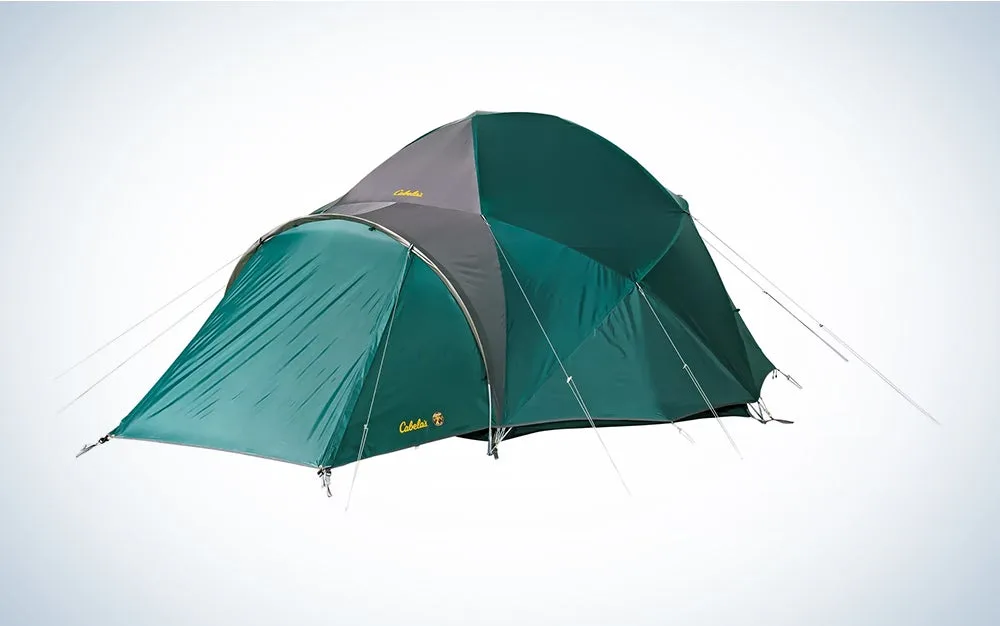
Specs
Materials: 210-denier polyester oxford (tent body), 75-denier polyester ripstop (rainfly)
Dimensions: 10’3″L x 11’10″W x 6’1″H
Best Uses: Extreme weather camping
Pros
Comes with seam sealer and repair kit
Bathtub style floor
Excellent interior organization
Full coverage rainfly with vestibule for storage
Cons
Heavy (33 lbs)
Field tested in Alaska—so you know it can hold up in almost any winter weather—the Cabela’s Alaskan Guide Model Geodesic Tent is designed to withstand extreme conditions. The geodesic shape constructed with 7 shock-corded fiberglass poles is extremely rugged. The 75D polyester ripstop construction sheds rain and snow, and has a waterproof coating. The bathtub-like flooring is extra thick and is meant to keep out ground moisture, which could otherwise seep in from melting snow. The tent boasts plenty of storage pockets and gear panels. All in all, this is a great dome tent—and comparatively affordable.
Best for Ice Fishing: Frabill Pro Series Ice Hub Shelter

Specs
Materials: 600-denier polyester (tent body), 900-denier polyester (skirt)
Fishable sq ft: 44.5
Best Uses: Ice fishing
Pros
Fully welded insulation
Fits up to 3 people
Easy to setup and pack down
Includes ice anchors and tie down ropes
Cons
Quality varies
The Frabill Pro Series Ice Hub Shelter is spacious—it’s advertised as being able to fit two to three “bro-sized” anglers. The ice fishing shelter is fully insulated and boasts 600-denier polyester walls and roof, as well as an extra-tough 900-denier skirt section to protect against weather stress or errant boots. The ice shanty has 4 removable windows with shades, two interior pockets, and one exterior clear pocket license holder. When it’s broken down, it fits inside a duffle bag that has a built-in pocket to stash your tackle in. It’s easy to pack and carry, which is a plus when you need to change spots.
Best Budget: FireHiking Camping Hot Tent

Specs
Materials: Fiberglass cloth with flame retardant coating
Floor Area: 95.38 Square Feet
Best Uses: Backpacking, camping, bushcraft, fishing
Pros
Large vestibule
Can use with a wood stove
Ample air circulation with ventilation
Available in several sizes
Cons
Some features could be improved, but good value for the price
The FireHiking Hot Tent is a great option for the budget-minded winter camper. The tepee shape sheds snow and rain, and there’s a stove vent, which allows you to use a portable stove inside. The fully polyester outside is water-resistant and tough, though not as effective as a pricier winter tent offering. The tent is easy to assemble and can be stored in a backpack when it’s broken down.
What to Consider When Choosing a Winter Tent
Before purchasing a winter tent, think about the specific activities you’d use it for, and the conditions you’re likely to face. When it comes to facing unpredictable elements during the winter, it’s always better to err on the side of caution. You’ll want a camping tent that will protect you not only from the typical winter conditions you’re going to experience but also the most extreme ones. You can never truly predict when a blizzard is going to hit or when the temps will drop precipitously low. When it comes down to it, a winter tent is a fundamental piece of survival gear.
4-Season Tents vs. Winter Tents
The difference between a 4-season tent and a winter tent is that a winter tent is built to be warmer and more resistant to wind and snow. That said, you can find a high-quality four-season tent that will be able to handle most winter conditions—so long as you make sure to layer up, wear a hat, and bring a sleeping bag rated for sub-zero temps. So if you want to buy a tent that will suffice in the winter but be suitable for other times of year, or get a tent that’s light in weight, a four-season tent is an option.
Four-season tents have some attributes that make them an attractive option. They tend to offer more ventilation than a typical winter tent and are typically lighter to boot. When you’re on the hunt for a four-season tent, make sure you’re getting what’s advertised. A lot of companies will advertise a regular tent as “four-season,” without backing up this claim with features. Look for tents that have a heavy-duty frame and are fully waterproof—not just water-resistant.
Size and Capacity
Because winter tents must be especially strong to withstand wind and snowfall, are often set up amid small drifts of snow, and need to trap heat, they usually don’t have as much surface area as normal tents do. That means that the best winter tents are often in the 2-3 person range. If you go larger than this, the winter tents you’ll find will be pricey and difficult to pack. If you’re willing to foot the bill and are going camping somewhere you can access by SUV or truck to carry the tent, then a large winter tent is worth the investment.
Weather Resistance
Winter tents come in several different shapes and sizes. The shape is as important as fabric and pole material as far as how the tent will stand up to winter elements.
A-frame tents are common for backpacking because the shape is usually easy to break-down and pack. The steep walls of this style tent shed water and snow with ease, but the large, broad sides are weak in a direct wind. Two main structural poles cross to create a dome shape that is strong and easy to set up. They’re pricey, but they are the most storm-resistant option.
Budget
Winter camping gear is generally more expensive than normal camping essentials. Winter tents need to be made out of high-quality material if they have any chance of standing up to extreme winter conditions. If you’re on the market for a winter tent, consider buying the best-quality portable structure you can afford. That said, there are several less expensive options that will give you a good bang for buck value and keep you warm at night, as long as you’re willing to bundle up.
Additional Features
Many winter tents feature reinforced, fire-resistant stovepipe vent holes or “stove jacks” at or near the top of the tent. Portable camping stoves have pipe chimneys that poke out of that stovepipe hole and release smoke into the air. A stove will add weight to your load, but once you set it up inside the tent and get a fire going, it’ll warm up quickly.
FAQs
Q: What type of tent is best for cold weather?
The best type of tent for cold weather is one that is built for the season. So, if you are winter camping, having a 4-season tent is ideal as it provides better insulation and protection from winter weather conditions.
Q: Do you need a special tent for winter camping?
No, you do not always need a special tent for winter camping. You can winterize a 3-season tent, but it is not safe to do this in all winter weather conditions. Use caution when camping during the winter and ensure you have proper sleeping gear as well as shelter to protect yourself from the elements.
Q: Can you sleep in a tent in 30-degree weather?
Yes, you can sleep in a tent in 30-degree weather. Even 3-season tents can be used at these temperatures with the right precautions and sleep gear.
Q: How much warmer is a tent than outside?
A 3-season tent is only about 5 degrees F warmer than outside. 4-season tents range from 10-20 degrees warmer, and expedition or insulated tents can be up to 25 degrees F warmer.
Final Thoughts
You don’t want to cut corners when you’re camping in winter, because resisting the cold is key to having a good time. You’ll probably be outside all day, so make sure the tent you bring is a good one, with sturdy construction and good materials, so that you’ll be comfortable once you go inside of it. The best winter tents will let you focus on the fun, not on the shelter itself.
Why Trust Us
For more than 125 years, Field & Stream has been providing readers with honest and authentic coverage of outdoor gear. Our writers and editors eat, sleep, and breathe the outdoors, and that passion comes through in our product reviews. You can count on F&S to keep you up to date on the best new gear. And when we write about a product—whether it’s a bass lure or a backpack—we cover the good and the bad, so you know exactly what to expect before you decide to make a purchase.

